Building Peace in the Turbulence of Vancouver’s Downtown East-side
- John de Haas
- Jun 12, 2023
- 9 min read
Updated: Oct 11, 2023

Vancouver is Awesome: How do you explain Vancouver’s Downtown East-side to tourists?
It’s complicated…
On June 6th, at the Alternate Dispute Resolution British Columbia (ADRBC) 2023 Symposium, I co-chaired with Kathleen Soltis MA a plenary session regarding the dismal state of Vancouver’s Downtown East-side (DTES). Premier Eby, who is very familiar with the DTES, recently said “Haven’t seen it worse”.
Holding the session was deemed to be valuable in exploring why over the last many years virtually every initiative to improve one problem or another has failed to bring calm. The evidence is that the situation is continuing on a trajectory of further safety, social, health and economic deterioration. Something is missing in the responses. So, there is a lot to learn in the DTES over addressing layered and complex conflicts.
Just facing complexity can feel overwhelming and stressful in itself. A sense of security is commonly found by working within established worldviews, experiences and training. For many interest-based ADR professionals that means focusing on what appear to be the obvious ‘problems’ and finding logical ‘solutions.’ The process involves something like - separating the people from the problem, identifying the interests, setting a joint goal statement, determining the criteria to evaluate ideas, brainstorming solutions and then building consensus on an agreement. The fire should then be out.
But, in the DTES the pattern is that another fire then breaks out elsewhere. This has been true for such ventures over the years as stand-alone harm reduction initiatives, the movement of sex workers from residential areas, forced de-camping or overwhelming policing. Pushing down symptoms has shifted disorder rather than ended it.
The symposium panel session offered the opportunity to think about how to navigate resolutions beyond the constraints and protocols that are predominant in today’s ADR training and practices. The DTES actually requires a deeper approach. It contains a unique composite of interconnected components that demand an in-depth analysis and the design of a holistic, integrated resolution process.
The session began with a context presentation, followed by a keynote address on the DTES by Wally Oppal. The panelists were then asked to speak to what conflicts they perceived were present and their causes, as well as who was responsible to resolve them and what the path forward was.
The panelists in order of speaking were:
Jessie August MA - a member of the Shishalh Nation.
Brian Montague - Vancouver City Councillor
Niki Sharma KC - B.C. Attorney-General
Howard Chow MA - VPD Deputy Chief Constable
Wally Oppal KC - former Arrorney-General and former Judge
John Radford Ph.D. of Transpectives Consulting
Here is the opening context presentation of the current realities in the DTES:
Vancouver’s Downtown East-side
When we refer to the Downtown East-side, it is an ill-defined geographic area in the city of Vancouver - which typically is considered to encompasses the city’s oldest neighbourhoods:
o the original Gastown, Railtown
o the Chinatown business district,
o the Strathcona and Oppenheimer residential areas
o the Victory Square commercial area, and
o the Hastings strip that runs through the center
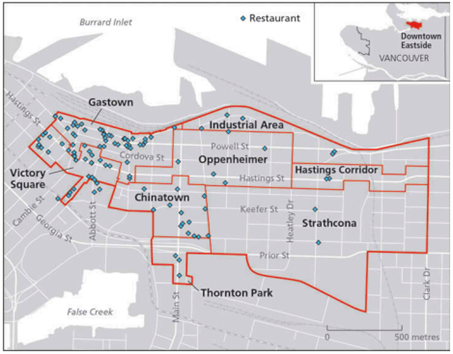
Wikipedia
The Downtown East-side is characterized by its old buildings, along with its Single Room Occupancy residences - which were once hotel rooms in another era. The area deteriorated as the city moved outward in all directions. The population also gradually changed. The Downtown East-side is now known for its social disorder and overwhelming human tragedies.
For those who may be unfamiliar with the situation of the Downtown East-side – there is turbulence and complexities that the panelists will be referring to.
The media has regularly reported over the last two to three decades on the worsening transformation. Their images are probably the easiest way to grasp what is going on.
To begin with - The Downtown East-side today contains an enormous marginalized population – residing there or frequenting the area. They were and are drawn by the cheap housing, considerable basic social supports, and the robust networks of suppliers and clients of the informal-illegal economy – which we will briefly look at further below. When there is no where else to go – there is the Downtown East-side.
Marginalization is not a noun or identity – it is a verb – it is the separation of relationships. Unlike multiculturalism programs that seek to bring diverse cultural and ethnic groups together, marginalization is a social exclusion of those seen to be undesirable. The marginalized population’s state of affairs is at odds with conventional and neoliberal Canadian ideals and expectations of self-reliance, moral conduct, law abidance, and public order. The Downtown East-side therefore does not have a sense of community, but of multiple ‘us’ versus ‘them’ relationships - characterized by differences in empowerment and recognition.

Vancouver is Awesome

Vancouver Sun: Why compassion is failing Vancouver’s Downtown East-side
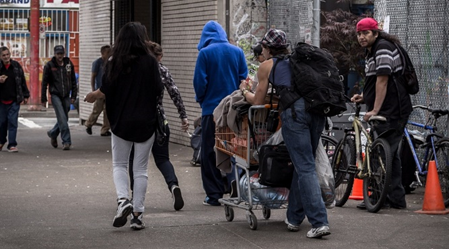
Daily Hive

CBC
This population includes those who:
v Are living in poverty – the Downtown East-side is reported as Canada’s poorest postal code.
v Are homeless – with many living in alcoves, lanes and in tents on the streets and in the area’s parks. Some homeless are so by choice – thought not always through rational choice.

Globe and Mail: Vancouver’s Downtown East-side

Georgia Straight: Oppenheimer Park

Dreamstime.com: Homeless people in Chinatown on the street
v Are suffering mental health issues, including trauma, FASD, etc. – following the neoliberal ideology that led to deinstitutionalization in the 1980s of psychiatric resources.

The Walrus: ‘Skid Row – an escape from Reality’
v Are drug-addicted – whose numbers increased considerably with the spread of hard drugs from the 1990s onwards – with the Downtown East-side today being the epicenter of the province’s ongoing daily opioid overdose death epidemic.
Gabor Mate in his new book The Myth of Normal says – “Vancouver’s Downtown East-side, a neighborhood notorious as North America’s most concentrated area of drug abuse. Within its few square blocks dwell thousands of people living lives of desperate dependence on substances of all kinds, inhaling, ingesting or injecting alcohol, opiates, nicotine, cannabis, cocaine, crystal meth, rubbing alcohol. Even visitors from New York or Detroit or Bristol are routinely shocked by what they see there.”

Globe and Mail: On Cheque Day, a toxic mix of money and drugs in Vancouver’s Downtown East-side
v There is an over-representation of Indigenous peoples (especially female) in the marginalized population – a consequence of the devastating impacts of colonization (involving social and economic destruction, residential schools, outlawing of culture and language and other policies) and systemic racism.
The conditions of those who are marginalized are often combined, interrelated, and exacerbate one another.
This large concentration of marginalized people is associated to several public behaviors which are considered unacceptable by mainstream society, including:
Ø The open use of drugs

Vancouver Sun
Ø The trafficking of drugs

Vice: Hanging with a Meth Dealer in Vancouver, Canada
Ø Street level survival sex work
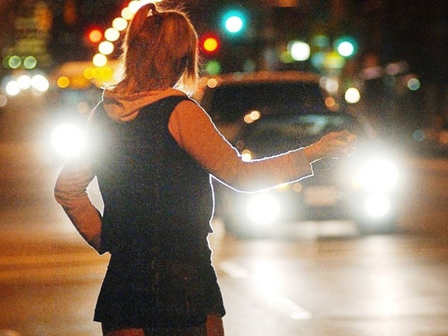
Vancouver Sun: Vancouver sex workers on edge after recent violence in DTES
Ø Pan-handling

Reddit: Vancouver police searching for panhandler who allegedly attacked driver
Ø Disturbances

Daily Hive: VPD officers use Taser, beanbag on ‘aggressive’ man in DTES
Ø Property crimes of break-ins, thefts, and damage to property

Aha media – at the scene of a suspected thief being tackled in the middle of Main and Hastings in Vancouver Downtown Eastside. “Apparently the guy had broken into a car parked on Main Street and stolen a camera.”

Vancouver is Awesome: Smashing spree causes more than $50,000 in damage in DTES
Ø Violent crime
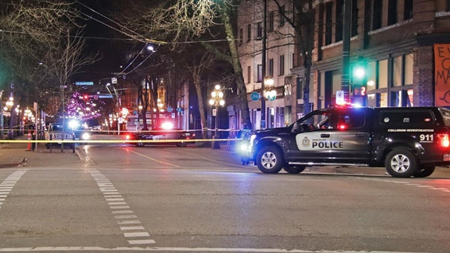
Global News: 5 people arrested after person reportedly shot in Vancouver’s Downtown East-side
Ø In fact, the Downtown East-side has the city’s highest overall crime rate.
Ø And a high victimization rate – let’s not forget that the Downtown East-side was the source of many of the victims that serial killer Robert Pickton murdered.
Ø And as well, organized crime is prevalent in the supply and distribution of illegal drugs, and at times in property crimes and street prostitution – and they have a stake in the status quo.
The activities of those who are marginalized are most often survival-oriented in one manner or another.
There are more layers to the situation in the Downtown East-side.
The turmoil of the Downtown East-side also includes:
· The collapse of businesses in historic Chinatown, Hastings Street and Gastown

Daily Hive: “Haven’t seen it worse” BC premier promises plan for Vancouver’s DTES
· And a negative impact on Vancouver’s and Canada’s reputations. The area has international notoriety.

NBC News: Canada’s Olympic city has notorious skid row
· In this equation as well are dozens of agencies, both governmental and NGO, who are focused on one issue or another. They are often funded by grants and donations. Most are well intended, but not always evidence-based in their endeavors. They create employment and naturally form some degrees of self-interest – and an interest in keeping the status quo.
· Also, a variety of problematic narratives have emerged and become entrenched in the Downtown East-side, along with their advocacy groups – who arguably may have an interest in the status quo.
o One is regarding the negative perception of police and the promotion of such ideas as defunding and ever-greater civilian oversight/control

Pivot Legal Society – Police violence in the DTES
o Stories of socio-economic conflict

Spring – A magazine of socialist ideas in action
o Some call it a humanitarian crisis – the perceptual frame that assistance is required to save a victim population that has suffered some disaster.

Blog by Barj Dhahan – originally published in the Vancouver Sun: Single coordinator needed to end humanitarian crisis in DTES
There have been many concerns, alarms and reactions over the years to the disorder and issues of the Downtown East-side.
Most recently a Fire Department removal order was enforced by city staff with police support - resulting in open conflict – along now well-worn patterns of confrontation and rhetoric.

Western Investor: Battle of Hastings: police, city crews remove homeless camp
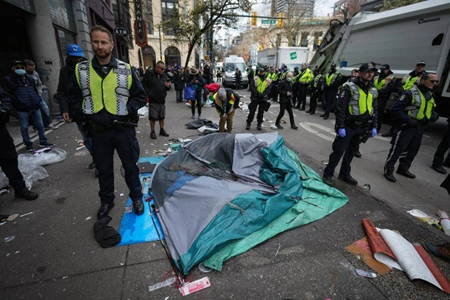
Haida Gwaii Observer
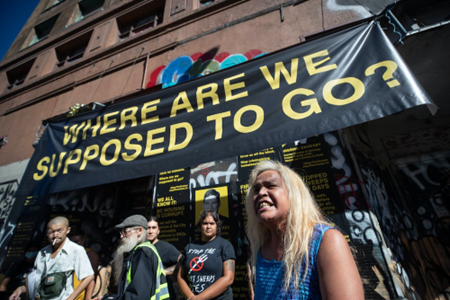
The Conversation
Looking at the dismal state of the Downtown East-side today, it seems that the many rights-based and interest-based ‘solutions’ have not succeeded in creating a stable, peaceful and livable community.

Vancouver is Awesome: How do you explain Vancouver’s Downtown East-side to tourists? It’s complicated…
Today in the Downtown East-side there is much disorder and suffering.
The search for the path forward has never been more important.
To find that path there is the need to understand much history, the interwoven layers and complexities, and the very different views of what is happening and what needs to be done about it.
The panelists then spoke over their perceptions of the situation and what the path forward might be.
I will be bold and summarize what I interpreted as some key thoughts - without attribution:
o There is a general lack of awareness and comprehension over the impact of colonization on the social, emotional, psychological, and spiritual aspects of Indigenous people – and of the intergenerational trauma that flows from that. The damage in some communities is so severe that for many the DTES is percieved as a better alternative. Aside from culturally aligned services, therefore there needs to be greater public understanding, along with changes to often unrecognized institutionalized colonial attitudes and practices.
o There is a lack of organization and co-ordination between the multiple services and agencies in the DTES. What is needed is an overall plan which contains defined goals, roles and responsibilities, along with a clear and empowered comprehensive management structure. As well, strategies should not be stand-alone, but work in concert and/or be created to provide a complete response.
o There is indeed a lack of co-ordination amongst the agencies in the DTES – which is problematic. As well, there is the matter of relationships and cultural worldviews – in particular Indigenous traditions and ‘orders.’ One approach that would help is broadening the application of restorative justice. Trauma is another aspect that requires greater understanding and adaptions by service providers.
o There is a reality that cannot be overlooked when responses to the DTES are considered. There is a high level of violence that makes some of the opinions and solutions presented by different individuals and groups as untenable. Most disturbances involving apparent mental health issues have a level of violence that health care workers are not trained or equipped to safely handle. There are narratives as well that fuel ongoing conflicts and do not necessarily represent the best interests of the DTES marginalized population.
o Canadian society as a whole requires a paradigm shift away from not caring. Indigenous peoples, and females in particular, have suffered from a culturally ingrained indifference. As well, there needs to be an integration of the various support and service systems that are in place so that they communicate and work better together for the most vulnerable. They are too splintered at present.
o Complexity is best looked at within a systems framework. This requires using analysis tools that lay out such pieces of information as: what is happening, why is it happening, how did this come about, who is involved, what viewpoints and needs are present, what trauma is underneath, what relationships exist, what rights are involved, what stories are circulating, what patterns are entrenched, what goals are most appropriate, what a resolution process needs to shape itself around, what strategies make the most sense, what will happen when actions are taken, who can assist, what will be barriers, and what information is missing. The process of conscious curiosity raises questions and prompts the engagement of multiple parties. Working together in a systems approach builds community and its capacity to reduce turbulence.
In my view, the session was insightful and pointed to the value of holding a much broader and lengthier discussion on the turbulence in the Downtown East-side and the path forward to creating a peaceful, vibrant and healthy community. That larger discussion should be comprehensive. Rather than marginalizing people, a paradigm shift towards their inclusion in the conversation is essential – a we, rather than an us sorting 'them' out.
I am also convinced that more ADR approaches and tools would be helpful. The prevailing ‘interest-based’ framing and methodology does not address many of the layers and complexities that are present. First, needed is the application of a systems-based analysis. Then it would be advantageous to engage and integrate ADR approaches focused on relationships, narratives, trauma and insights. I have provided several references below to corresponding literature. I believe this all-encompassing ADR strategy for the turmoil of Vancouver’s DTES is the best path forward to order, safety and hope.
ADR references:
Interest- based (solving the problem)
Getting to Yes: Negotiating Agreement Without Giving In (1981)
Roger Fisher and William Ury
Transformative (changing the dance)
The Promise of Mediation: The Transformative Approach to Conflict (2004)
Robert A. Baruch Bush and Joseph P. Folger
The Little Book of Restorative Justice (2002)
Howard Zehr
Narrative (changing the story)
Narrative Mediation: A New Approach to Conflict Resolution (2000)
John Winslade and Gerald Monk
Practicing Narrative Mediation (2008)
John Winslade and Gerald Monk
Insight (changing the self in the dance)
Transforming Conflict through Insight (2008)
Kenneth R. Melchin and Cheryl A. Picard
Practicing Insight Mediation (2016)
Cheryl Picard
Trauma-informed (changing the self)
Why Good People do Bad Things (2008)
James Hollis
The Myth of Normal
Gabor Mate



Comments